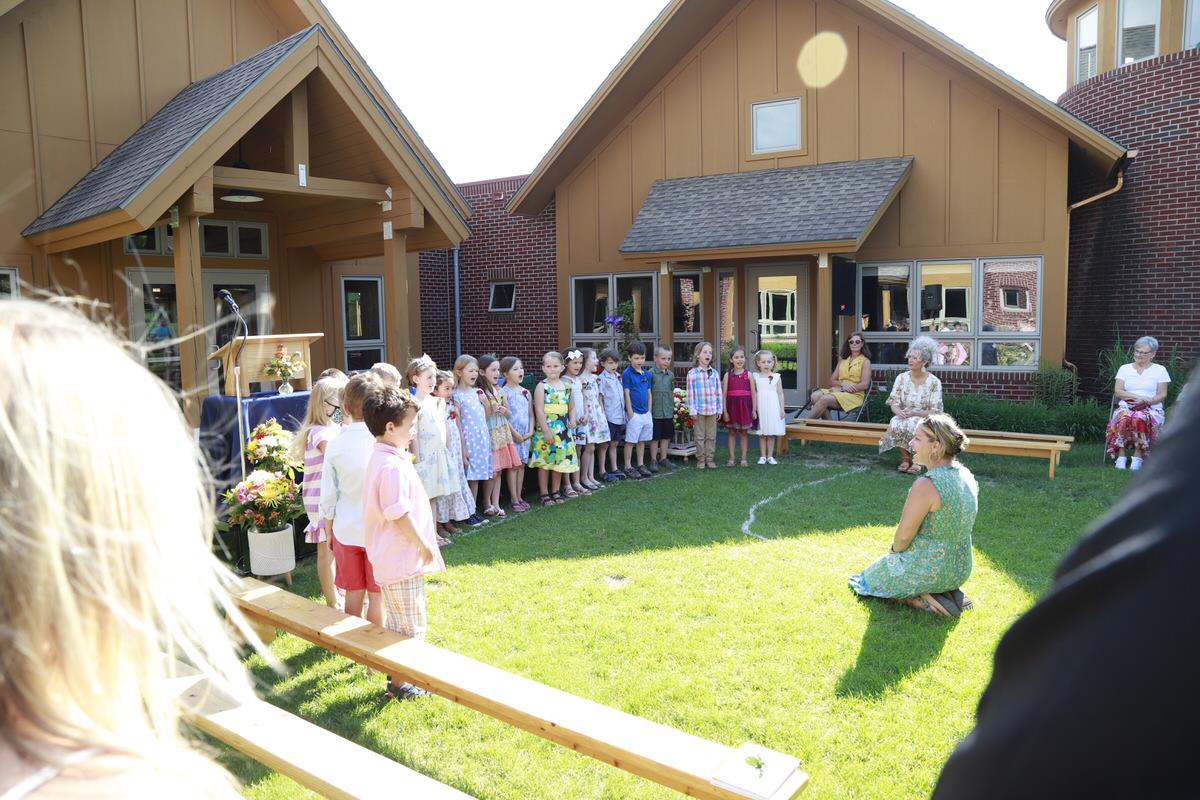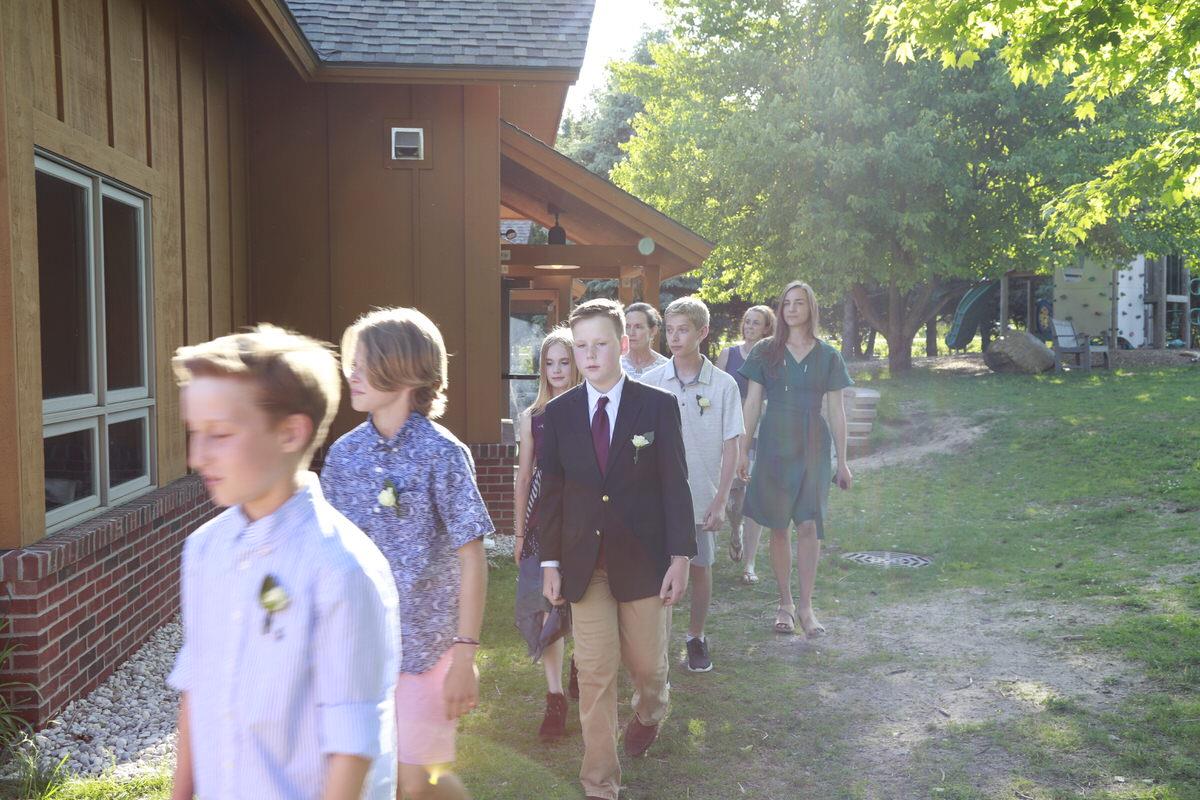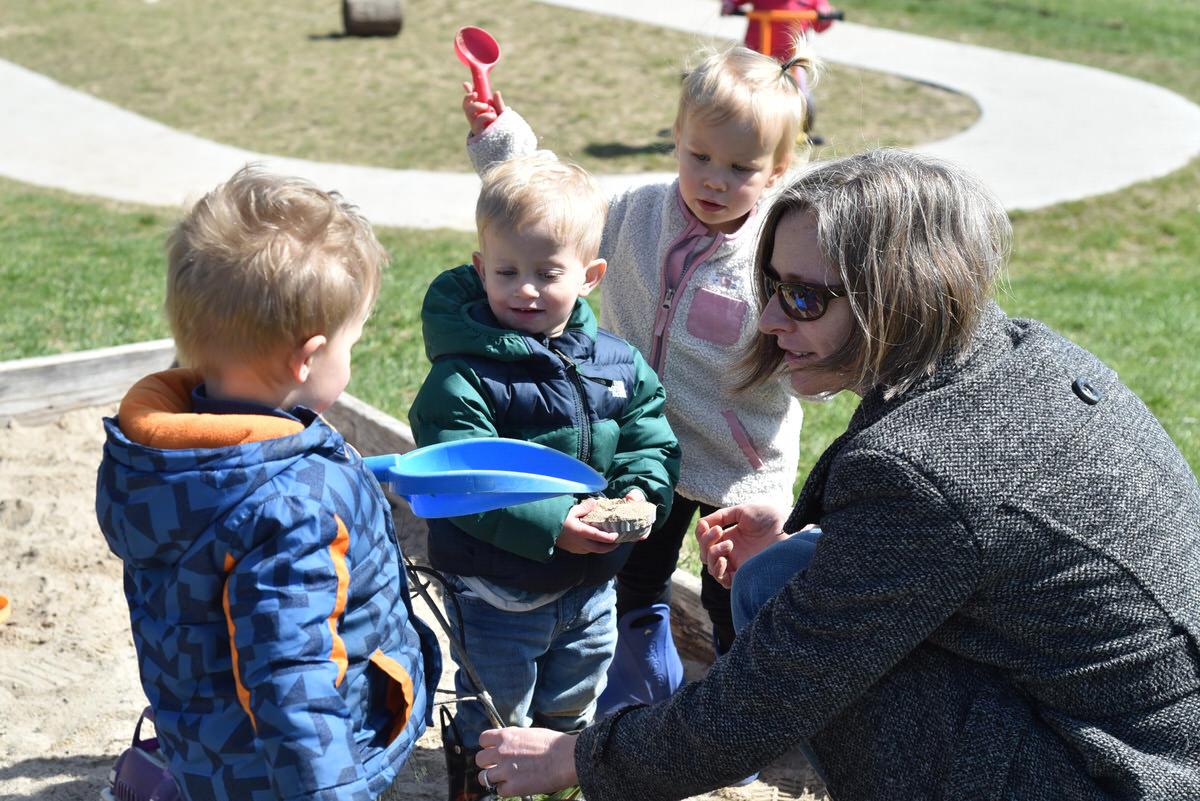The Children’s House was founded in 1984 in a small farmhouse in Sutton’s Bay. In the early years, the school consisted of one Toddler community and one Primary classroom. When the children completed their Kindergarten year, they moved on to different schools for elementary. During this time, traditions were created that have continued to be celebrated throughout these past 38 years.
As our school has grown to include elementary and junior high, our final weeks of school now include day trips, overnights at Leelanau Outdoor Center, and camping and backpacking trips. Endings are celebrated with moving-up ceremonies and graduation. But the signature all-school event that has remained the same at its core is Dance of the Cosmos.
In the beginning, kindergartners assumed the role of the planets in our solar system. An extension of the birthday celebrations in Primary, children have a tangible experience of walking around “the sun” as they begin to learn about the universe and their important place in it. Sometimes, parents would fill in to play roles in the solar system to supplement the single group of kindergarteners.
As the school make-up expanded to include elementary and junior high, distant galaxies, black holes, and a supernova were included, all choreographed to the music of Gustav Holst. The current iteration of this beautiful year-end celebration is a symbolic homage to our past and present.
Our year-end celebrations have expanded and changed to reflect the evolution of this incredible school. They are an honoring of our beginnings and ground us in our past, while demonstrating the growth of our present. Over the inevitable changes of time, these traditions root us all back to our origins that reflect the roots of this community. And every year, we are reminded that the universe is a wonderful place. It goes on, and on, and on…
We often hear the terms “praise” and “encouragement” in a wide variety of school settings. Praise is typically defined as expressing approval or admiration whereas encouragement is a more supportive action that points out facts without tying them to an evaluation of one’s work. In a Montessori classroom setting, we provide encouragement by noticing. This may be as simple as “You spent the whole morning on your cursive handwriting,” or something more complex such as, “It felt helpful when you cared for our community by setting the lunch table.” Maria Montessori recognized observation as a tool to know and understand the child. By using an observational approach to encouragement in the classroom, we are able to provide an unbiased report of the work a child does.
Children in a Montessori classroom setting build their independence as they grow in each multi-age classroom. Not only are they able to practice skills, they are able to meet their own needs independently. These opportunities help a child build self-confidence and intrinsic motivation to complete tasks or care for themselves without adult intervention. By providing opportunities for success such as child-sized furniture and accessible resources, the adult is able to help build into this motivation for independence. In nurturing a child’s spontaneous development and innate interest to become independent, we are helping children to build skills of self-confidence that will serve them for a lifetime. Maria Montessori said, “The aim of the children who persevere in their work with an object, is certainly not to "learn;" they are drawn to it by the needs of their inner life, which must be organized and developed by its means. In this manner they imitate and carry on their “growth”.” (Spontaneous Activity in Education).
Encouragement is a beautiful tool in a mixed age classroom. It becomes important as each child is practicing different skills and bringing a variety of abilities to the community. By providing support and sharing observations, the component of comparison is removed. Rather than hearing “You’re a good reader!” about a peer and automatically reverting to a low level of confidence in their own reading abilities, children understand and have support to confidently improve themselves. Hearing encouragement such as, “You really practiced reading today. Practice makes challenging books feel easier.” can provide a directly supportive fact without tying the child’s ability to a positive or negative connotation. This may aid children who are resistant to difficult materials or skills and allow grace in the process of learning. When a child is offered praise, they may be conditioned to then seek this approval in future work to deem it “successful”. When we offer sincere and specific observations about a child’s work, we are able to offer encouragement that may help them to build skills.
Creating an environment of encouragement rather than “praise” goes hand in hand with the Montessori philosophy. In a classroom setting, you may hear your child’s guide talk about the process of work over the product. Montessori knew that children learn best by using concrete manipulative materials, so the process and work completed during the work cycle are of utmost importance. A child may paint daily only to spend the majority of their time cleaning the paint palette and easel or choose to carefully peel and chop a carrot without the intention of eating it. This interest in the process and the opportunity to encourage a child’s effort become paramount in helping to form a child’s abilities. Children may not always bring home physical manifestations of their work each day, but the formation of this process is the most important part of their work. When we offer children praise, we attach a need for external response in order for a child to deem their work successful. When offering encouragement, one is able to provide sincere feedback and focus on the effort rather than the final product. Without providing external evaluation of work quality, children are able to notice their own interests, abilities, and merit.
What language can we use to provide encouragement to children? Here are some examples:
“I noticed…”
“How do you feel?”
“You’re almost finished!”
“You did _________ all by yourself.”
“It felt really helpful when you…”
“You put your jacket on!”
When we use the language of encouragement, we can sit back and observe, ask open-ended questions for opportunities for reflection, model a task, or simply describe effort, materials, and action. The confidence that we can help each child achieve when they feel supported and encouraged rather than evaluated is an incredible gift that Montessori recognized and integrated at each level of development.
As a parent of a child attending a Montessori school, you have heard the phrase “freedom and limits” many times during conversations with your child’s guide. What does it really mean? What is freedom and why do I need to apply any limitation to my child’s actions?
Dr. Montessori said that “discipline must come through liberty.” She meant self-discipline, which develops naturally when a young child is allowed freedom.
In Montessori classrooms, every child is free to move, and make their own choices, and mistakes. They move freely around the classroom performing meaningful, purposeful activities, which often are the same activities of the adults in their life. Being trusted to open a cupboard and get the plates for setting the table or push the button on the washing machine are only a few examples of young child “privileges.” Allowing the child to perform the real everyday activities of practical life boosts their self-esteem and develops self-discipline and self-control.
Often, when young children seemingly misbehave, what they really are doing is following their “horme.” Dr. Montessori used that term to describe the “life energy” which is the power that moves the children forward in their development.
When the child discovers that he can open the door of the cupboard he often tends to stand in front of the cupboard, opening and shutting the door an endless amount of times. Is there something wrong with it? At home, when the child is the only young person in the family I probably would let it go until the urge of closing and opening the door is met. At school, it could be slightly problematic in the classroom with twelve young toddlers. This activity may take a long time and it keeps other members of the community from access to the cupboard, which eventually delays the moment of setting up the table for snack, which affects some of the youngest children who are hungry and not able to focus on the group time. As a teacher, I need to “apply limits” to the activity of opening and shutting the door of the cupboard by redirecting my young friend to some other activity. It can be a work on the shelf, a box with latches.
I would say “I see that you want to open and close something. You can work with a latch box.” Or I would introduce the latch box later during the day and bring the child back to help with setting up the table for snack: “Do you remember? We need a plate for Teddy, can you take one plate from the cupboard?”
Around two years old, the child experiences a self-affirmation crisis. During that period the child exhibits a strong need for exercising his will, they aren’t able to reason yet and simply want what they want. It is our role to help children feel safe and applying limits helps with that. When we are clear and serious about limits and consistent with consequences, the child feels that we will take control when necessary. For example, when the child is running away from us on the sidewalk, we need to react in a clear matter-of-fact manner and stop the child from danger. “I am going to help you stay safe and hold your hand.” We may expect that the child will protest and we still need to stay consistent and clear. The child may try to run away again, but every time we will apply the same limit: the consequence of holding hands. The need for running away will eventually wear off and we will be able to trust our child to walk along with us.
Children learn through the limits of what is acceptable behavior. Later the limits will evolve into responsibility. If you are a parent of a child who attends an elementary program, you will be familiar with the terms freedom and responsibility.
There are many ways to prepare yourself how to set the limits, as there are many ways to say “no” to the child, which actually do not sound like rejection. But this is another subject. For more information, please visit the Aid to Life website or contact me.




